Content Editor: Yao Erling
Content Organizer: Yao Erling
What is the Social Layer
The social layer utilizes the decentralization, transparency, and security of blockchain to provide users with a more secure, privacy-protecting, and fair social experience. These platforms allow users to have full control over their data, participate in decentralized governance, ensure data transparency and tamper resistance, and enhance security through decentralized identity authentication.
The social layer is currently divided into four different major types: social token platforms, decentralized identity authentication, social finance platforms, and hybrid architecture platforms.
Social Token Platforms: These platforms include functions for content creation and decentralized storage of user data. Projects of this type generally revolve around using tokens as incentives to drive the generation of community and creator data, enhancing and increasing the value of content, as well as user privacy and data control.
- $CYBER (Cyber Connect)
- Mirorr
Identity Authentication Platforms: Used to collect user information, record user data and identity through network activity and various information collection, ensuring data security and privacy, reducing reliance on third-party identity verification, and serving as real user information for task platforms.
- $GAL (Galex)
Social Finance Platforms: These platforms combine social and financial functions, allowing users to engage in financial transactions and investments through social interactions, creating new economic models.
- $FRIEND (Friend.tech)
- $TIP (TipCoin)
Hybrid Architecture Platforms: These platforms adopt a hybrid on-chain and off-chain architecture, with user identity and keys processed on-chain, and content storage and dissemination conducted off-chain, achieving efficient and secure social interaction.
- Farcaster
Friend.tech has gained market recognition for the popularization of PWA mobile stacks, but one issue is that not everyone has enough ETH to foot the bill for their favorite KOL.
This year, another attractive encrypted social rise is Lens, a web3 social graph protocol focused on data portability, allowing users to enjoy a range of applications supported by Lens, such as Orb, Hey, and Tape.
Farcaster Decentralized Social Platform
Farcaster is a decentralized social network that enables developers to build innovative social networks. It is an open protocol that can support many clients, much like email. Users will always be able to freely move their social identities between applications, and developers will always be able to freely build applications with new features on the network.
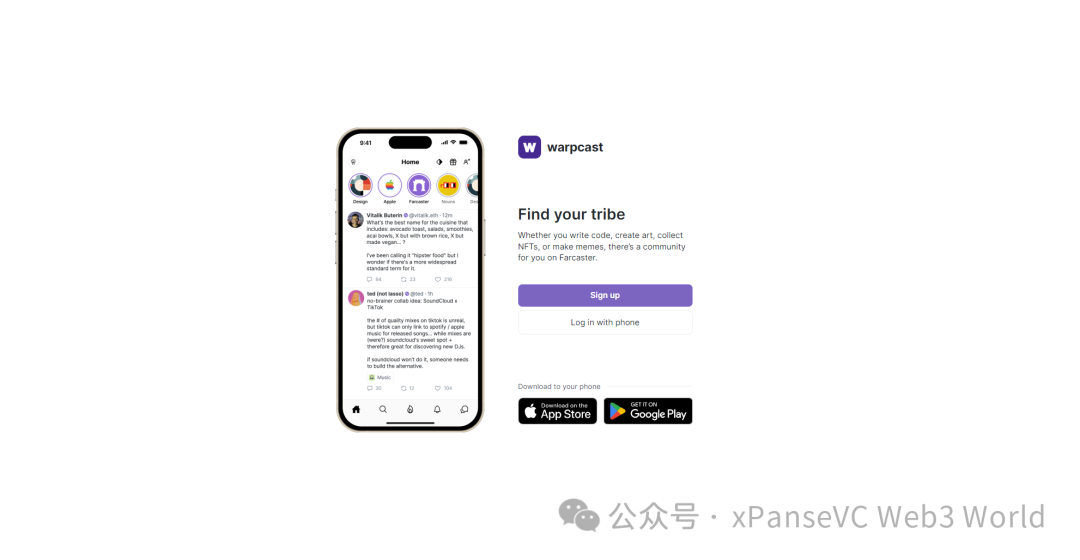
Farcaster account creation is managed on the Optimism L2, making registration fees "wallet-friendly." Like Lens, Farcaster is a protocol that supports decentralized applications, and users can use Farcaster in a variety of ways.
Of course, this decentralized portability approach is the cornerstone of Farcaster's design, as it reinforces user control over data (in stark contrast to the data silos of web2 platforms) and promotes permissionless application development (in contrast to centralized "walled garden" app stores).
Farcaster Hybrid Architecture
Farcaster has a hybrid architecture that stores identity on-chain and data off-chain, verifying user information data through a hybrid contract architecture on-chain and off-chain. User identity and key information are processed on-chain, while content storage, verification, and dissemination are handled off-chain.
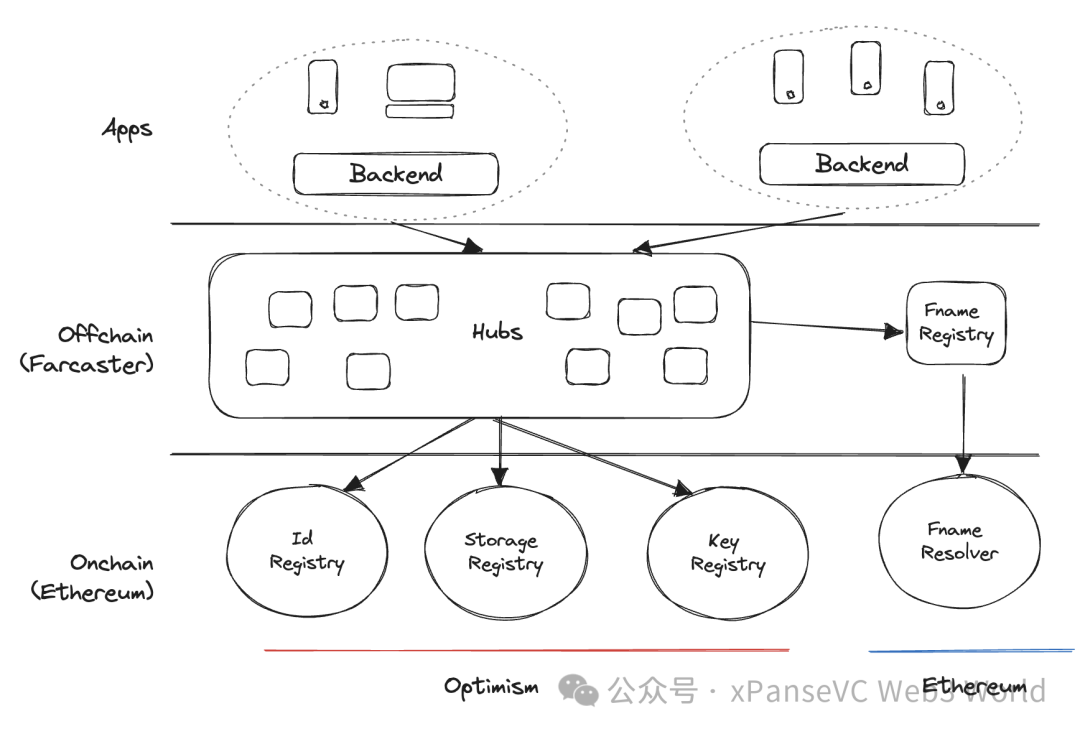
On-Chain Storage and Verification
Farcaster's on-chain system is implemented in the form of contracts on the OP mainnet. On-chain operations are only executed when security and consistency are critical. The use of on-chain operations is kept to a minimum to reduce costs and improve performance.
On-chain data verification and storage are built using OP STARK by Opitmism, with explicit agreements:
- Identity Registry - Create new accounts
- Storage Registry - Rent storage space to accounts
- Key Registry - Account and delete Key Registry
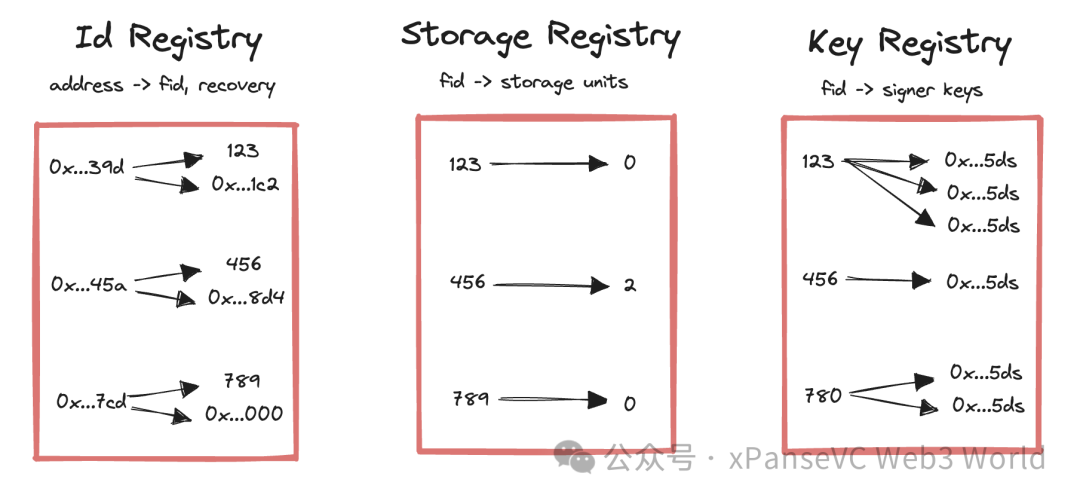
Identity Registry
The IdRegistry allows users to register, transfer, and recover Farcaster accounts. Accounts are identified by a unique number (fid) assigned to an Ethereum address at registration. An Ethereum address can only have one account at a time, although it can freely transfer it to another account. It can also specify a recovery address that can transfer the account at any time.
Storage Registry
The Storage Registry allows accounts to rent storage space by making payments in Ethereum. The storage price is set in USD by the administrator and converted to ETH using the Chainlink oracle. Prices fluctuate based on supply and demand.
Key Registry
The Key Registry allows accounts to issue keys to applications so they can publish messages on their behalf. Keys can be added or removed at any time. To add a key, the account must submit the public key of an EdDSA key pair and the requester's signature. The requester can be the account itself or an application wanting to operate on its behalf.
Off-Chain Storage and Verification
Farcaster's off-chain system is a peer-to-peer server network called Hub used for storing user data. Most user operations are executed off-chain.
The Farcaster Hub is a distributed server network used to store and verify Farcaster data. By running specialized software, computers can become Farcaster Hubs, which synchronize on-chain and off-chain data from Ethereum and other hubs. Each hub stores copies of all Farcaster data and provides data access through an API.
The Hub first synchronizes data from Farcaster contracts on the Optimism blockchain.
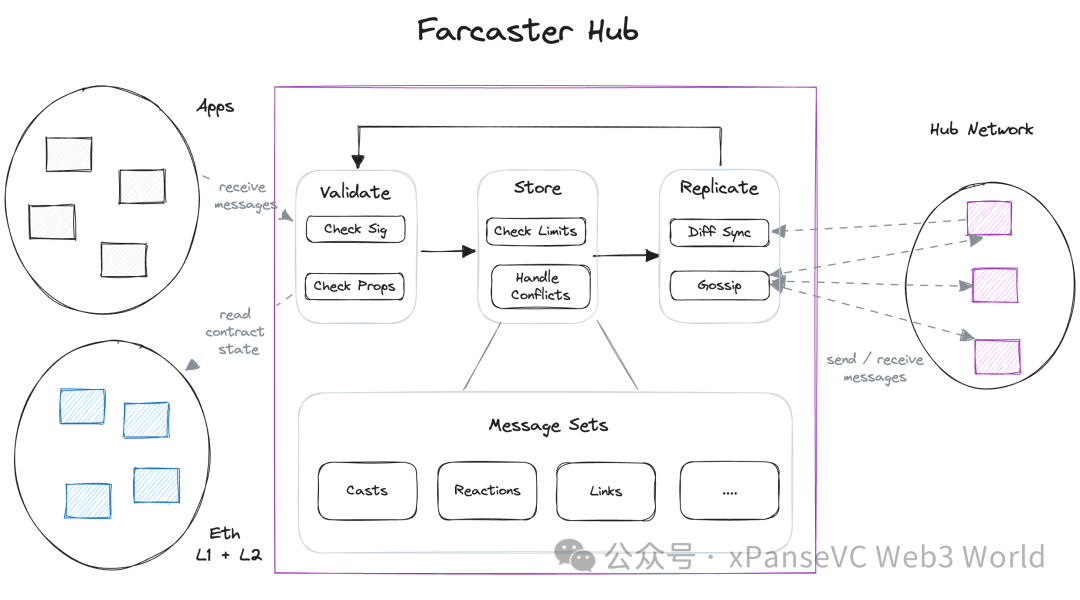
The Farcaster Hub is a distributed server network used to store and verify Farcaster data, supporting data reading, writing, and storage, and ensuring message validity and storage order through signature verification and conflict resolution mechanisms. Hubs use gossip protocols and differential synchronization to ensure data consistency between hubs, with eventual consistency allowing for recovery after disconnection, and monitor and score peer behavior through a peer scoring system to ensure hub reliability and performance.
Farcaster Data
The project Frames issued on Farcaster saw a significant increase in daily active users (DAU) since its release, highlighting the profound impact of this innovative feature. You can see from this Dune Analytics Dashboard that DAU soared to over 10,000 within a few days of Frames' release.
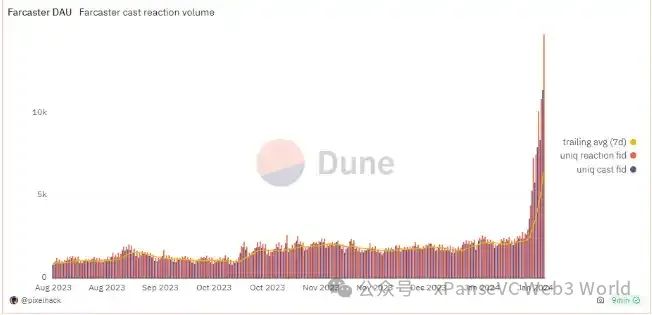
The future of Frames is promising, and social interactions will be more dynamic and engaging than ever before. With continuous innovation and development, we can expect Frames to evolve into a more immersive and interactive experience within the Farcaster ecosystem. From seamlessly integrated gaming experiences to simplified shopping and interactive narratives, Frames is the key to unlocking a new era of social media interaction.
Different from Other Projects
Farcaster's strength lies in its ability to attract and retain a large number of active crypto-native users, forming a high-quality community. The platform, through its openness and developability, allows developers and the community to freely create and distribute tokens, driving innovation. Farcaster provides users with autonomy, meeting the common needs of creators, developers, and ordinary users, without relying on complex financial incentive models. These advantages combined make Farcaster a diverse and high-quality decentralized social platform, driving high user engagement and activity.
Farcaster also introduces a feature that allows the community to independently issue tokens, bringing the unique feature of public issuance of tokens by smart contracts into the project. Farcaster not only completes the underlying transformation of social media but also provides a new way of asset issuance, fundamentally changing the "Fi" attribute in traditional SocialFi. It does not design complex financial structures for itself but provides this openness to the community and developers, becoming a launch platform for community tokens, community culture, and community ecology.
Investor Lineup
As of now, Farcaster has completed a total of 2 financing events, raising a whopping $180 million in funding, and achieving a valuation model of up to $1 billion in the latest round of financing.
The first financing event took place on July 13, 2022, completing a $30 million seed round of financing led by a16z, with participating institutions including Coinbase Ventures, Multicoin Capital, Standard Crypto, 1confirmation, Archetype, Scalar Capital, Ribbit Capital, Canonical Crypto, Volt Capital, A.Capital, Chapter One, First Round Capital, Offline Ventures, Todd and Rahul's Angel Fund, Haystack, Proof Group, Floodgate, Ansa Capital, Mischief, Balaji Srinivasan, Elad Gil, Punk 6529, and Raymond Tonsing.
The second financing event took place on May 21, 2024, achieving a $1.5 billion Series A financing at a valuation of $1 billion, led by Paradigm, with participating institutions including a16z, Union Square Ventures, Standard Crypto, Haun Ventures, and Variant Fund.
Sector Environment
Currently, in the social sector, the project with the highest market value is likely Cyber Connect, which is a 2-layer blockchain designed for graph social networks, integrating a bridge network for users' information-closed data islands in the blockchain through infrastructure.
However, it is worth noting that currently, there is no project in the social sector with a valuation in the current market that can reach $1 billion. Even the diluted market value of the highest-valued project in the social sector, CYBER, is only $890 million. This gives Farcaster a strong position upon its launch.
At the same time, the reason why Farcaster was able to raise such high financing is, on the one hand, its outstanding performance in data. In an era where account autonomy is increasingly valued, especially for those who have experienced Twitter account suspensions, the significance of decentralization and autonomy is more deeply understood.
On the other hand, Farcaster's new gameplay has a high "aesthetic" appeal. The characteristics of social products are usually visual elements, and any content (good or garbage) will be very intuitively presented to users. Therefore, the negative impact of garbage information in social media is more severe than the garbage code on smart contract networks.
免责声明:本文章仅代表作者个人观点,不代表本平台的立场和观点。本文章仅供信息分享,不构成对任何人的任何投资建议。用户与作者之间的任何争议,与本平台无关。如网页中刊载的文章或图片涉及侵权,请提供相关的权利证明和身份证明发送邮件到support@aicoin.com,本平台相关工作人员将会进行核查。




